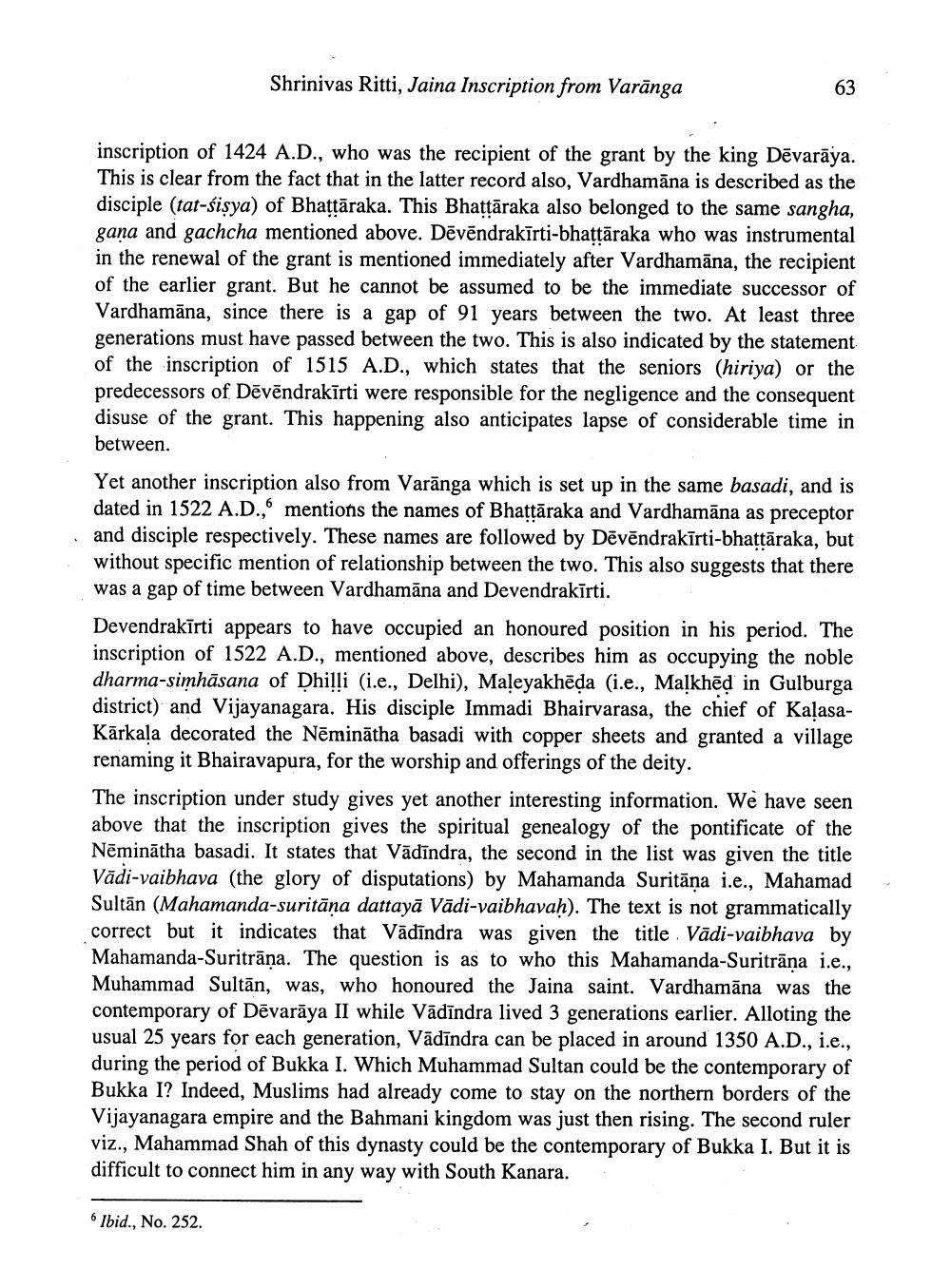________________
Shrinivas Ritti, Jaina Inscription from Varānga
inscription of 1424 A.D., who was the recipient of the grant by the king Dēvarāya. This is clear from the fact that in the latter record also, Vardhamāna is described as the disciple (tat-sisya) of Bhattāraka. This Bhattāraka also belonged to the same sangha, gana and gachcha mentioned above. Dēvēndrakīrti-bhattāraka who was instrumental in the renewal of the grant is mentioned immediately after Vardhamāna, the recipient of the earlier grant. But he cannot be assumed to be the immediate successor of Vardhamāna, since there is a gap of 91 years between the two. At least three generations must have passed between the two. This is also indicated by the statement of the inscription of 1515 A.D., which states that the seniors (hiriya) or the predecessors of Dēvēndrakīrti were responsible for the negligence and the consequent disuse of the grant. This happening also anticipates lapse of considerable time in between.
Yet another inscription also from Varānga which is set up in the same basadi, and is dated in 1522 A.D., mentions the names of Bhattāraka and Vardhamāna as preceptor and disciple respectively. These names are followed by Dēvēndrakīrti-bhattāraka, but without specific mention of relationship between the two. This also suggests that there was a gap of time between Vardhamāna and Devendrakīrti. Devendrakīrti appears to have occupied an honoured position in his period. The inscription of 1522 A.D., mentioned above, describes him as occupying the noble dharma-simhāsana of Dhilli (i.e., Delhi), Maleyakhēda (i.e., Malkhēļ in Gulburga district) and Vijayanagara. His disciple Immadi Bhairvarasa, the chief of KalasaKārkala decorated the Nēminātha basadi with copper sheets and granted a village renaming it Bhairavapura, for the worship and offerings of the deity. The inscription under study gives yet another interesting information. We have seen above that the inscription gives the spiritual genealogy of the pontificate of the Nēminātha basadi. It states that Vādīndra, the second in the list was given the title Vādi-vaibhava (the glory of disputations) by Mahamanda Suritāna i.e., Mahamad Sultan (Mahamanda-suritāna dattayā Vādi-vaibhavah). The text is not grammatically correct but it indicates that Vādīndra was given the title Vādi-vaibhava by Mahamanda-Suritrāna. The question is as to who this Mahamanda-Suritrāna i.e., Muhammad Sultān, was, who honoured the Jaina saint. Vardhamāna was the contemporary of Dēvarāya II while Vādīndra lived 3 generations earlier. Alloting the usual 25 years for each generation, Vādīndra can be placed in around 1350 A.D., i.e., during the period of Bukka I. Which Muhammad Sultan could be the contemporary of Bukka I? Indeed, Muslims had already come to stay on the northern borders of the Vijayanagara empire and the Bahmani kingdom was just then rising. The second ruler viz., Mahammad Shah of this dynasty could be the contemporary of Bukka I. But it is difficult to connect him in any way with South Kanara.
Ibid., No. 252.




